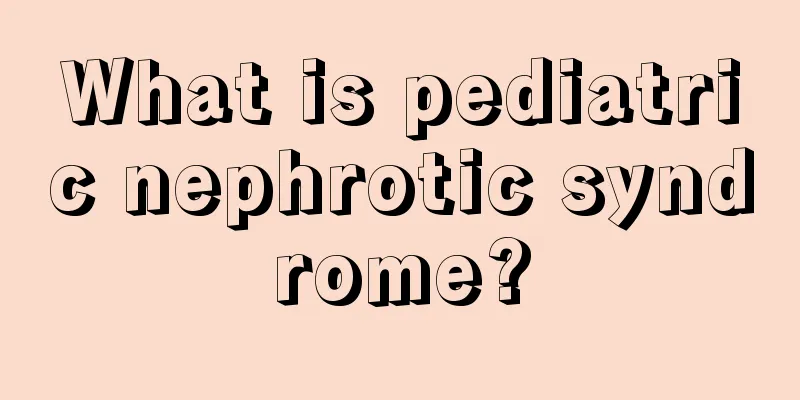What is pediatric nephrotic syndrome?

|
Many parents do not know what disease their children have when they have it. Some parents will choose to take their children to the hospital, but some parents will give their children medicine that they think is for the disease without understanding their children's symptoms, which may make the child's condition worse. So today I will tell you what pediatric nephrotic syndrome is. Symptoms and signs 1. Edema: The degree of edema in NS varies, and loose tissue and low body position are the most obvious. Edema moves with the action of gravity. When lying down for a long time or in the early morning, the edema is most obvious in the eyelids, back of the head or sacrum. After getting up and moving around, the edema is obvious in the lower limbs. In severe cases, there may be systemic edema, scrotal edema, pleural and abdominal effusion, and even pericardial effusion. When edema is severe, the local skin becomes shiny, thinner, and even white lines appear (mostly seen in the abdomen, buttocks and thighs). If the skin is damaged, tissue fluid will leak continuously. Serous effusion often produces compressive symptoms, such as chest tightness, shortness of breath, or difficulty breathing. Pleural and ascites fluids are often milky white, contain emulsified lipids, have very little protein (1 to 4 g/L), have a specific gravity lower than 1.016, and are negative in the Rivalta test, indicating that they are transudates. The degree of edema has nothing to do with the condition or severity of the lesion. Although it is related to hypoalbuminemia, the correlation is not close. Minimal change NS often presents with severe systemic edema, while moderate edema of the lower limbs is common in NS caused by membranous nephropathy and membranoproliferative nephritis. Edema is a prominent manifestation of a certain stage in the process of glomerular disease, and it may disappear on its own in some patients after several months or 1 to 2 years. The degree of edema is often affected by sodium intake. Urine output decreases before and during edema. 2. Hypertension: 20% to 40% of adult NS patients have hypertension, and about half of those with obvious edema have hypertension. Hypertension can be either renin-dependent or volume-dependent. Persistent hypertension is mainly related to underlying renal lesions. For example, about half of patients with membranoproliferative glomerulonephritis and focal segmental glomerulosclerosis have hypertension, while only about 1/4 of patients with membranous nephropathy have hypertension. There are even fewer microlesions, and even if hypertension occurs, it is mostly transient, and blood pressure returns to normal when the edema subsides. It is generally believed that hypertension caused by glomerular disease, especially in NS, is mainly volume-dependent, but is closely related to pathological changes. For example, the hypertension that occurs in minimal change disease and membranous nephropathy is mostly volume-dependent; the hypertension in NS caused by proliferative and sclerosing glomerulonephritis is both volume-dependent and renin-dependent, and most cases have both. In recent years, some people believe that plasma renin activity may not increase in glomerular diseases, and even in some patients, plasma renin is reduced. At the same time, there is a lot of evidence that impaired sodium excretion is a cause of hypertension in glomerular disease. Hypertension is usually moderate, with blood pressure usually between 18.7-22.7/12.7-14.7 kPa (140-170/95-110 mmHg). Therefore, hypertensive crisis or hypertensive encephalopathy rarely occurs in NS. 3. Hypoproteinemia and malnutrition It is well known that long-term and persistent heavy proteinuria leads to malnutrition. Patients show signs of malnutrition such as sparse, dry and yellow hair, pale skin, muscle wasting and wide white horizontal lines (Muchreke's lines) on the nails. When hypoalbuminemia is evident, the concentrations of other plasma proteins also change. Proteins of smaller molecular weight and similar charge to albumin tend to decrease and are lost primarily in the urine. For example, the excretion of thyroid binding globulin (molecular weight 36,500), vitamin D binding protein (molecular weight 59,000), antithrombin III (molecular weight 65,000), transferrin (molecular weight 80,000) and complement system factor B (molecular weight 80,000) in the urine increases, and corresponding symptoms may appear clinically. (1) Decreased thyroid function: NS patients are often in a state of hypometabolism, and reduced oxygen consumption may be related to systemic edema and decreased skin blood flow. Thirty years ago, people discovered that the amount of iodine bound to plasma protein was reduced, while the amount of iodine bound to protein in urine was increased. Giving patients large doses of thyroxine will not cause hypermetabolism, and the thyroid iodine uptake rate will be normal or increased. These data indicate that the excretion of triiodothyronine (T3) and thyroxine (T4) in urine increases, resulting in a decrease in their plasma concentrations and a hypometabolic state in the patient. However, plasma free T3 and T4 are often normal. (2) Hypocalcemia: As vitamin D binding protein is lost in the urine, the plasma concentrations of 25-OHD3 and 1,25-(OH)2D3 decrease, leading to intestinal calcium absorption disorders and disruption of bone response to parathyroid hormone. Patients develop hypocalcemia and secondary hyperparathyroidism, leading to osteomalacia and osteitis fibrosa cystica. The decrease in serum calcium is balanced by the decrease in serum albumin. It is generally believed that if serum albumin decreases by 10g/L, serum calcium will decrease by 0.25mmol/L and serum free calcium will decrease by 0.05-0.07mmoL/L. This is due to the decrease in albumin-bound calcium. If serum albumin decreases by 10g/L, HCO3- increases by 3.7mmol/L and the anion gap decreases by 3mmoL/L. Therefore, metabolic alkalinemia may occur in severe hypoalbuminemia. (3) Iron deficiency anemia: Due to the continuous loss of transferrin in the urine, patients may develop iron deficiency anemia. This hypochromic microcytic anemia is often ineffective against iron therapy. 4. Secondary infection Due to immune dysfunction (reduction of B factor, opsonin and IgG), large-scale protein loss, malnutrition and other factors, patients are extremely susceptible to secondary infection. The deficiency of complement system factor B leads to the loss of serum opsonic activity, and the increased catabolism of immunoglobulins in the kidney and their loss in the urine reduce the body's ability to resist infection, making secondary infection more likely. Common infections in NS include respiratory tract infection, urinary tract infection, skin infection and peritonitis. These infections often further exacerbate NS, and when antibiotics were not widely used, infection was the main cause of death in NS. Routine use of corticosteroids and anti-cytotoxic drugs to treat NS has resulted in an increased rate of secondary infection. The use of antibiotics to control and prevent bacterial infections has led to an increasing incidence of viral and fungal infections. Therefore, infection is still an important complication of NS. 5. Hypercoagulable state Most NS patients are in a hypercoagulable state and have a tendency to thrombosis. Addis (1948) first reported NS patients complicated by leg vein thrombosis, and later reported thrombosis in the pulmonary artery, axillary, subclavian, external jugular vein, coronary artery, brachial and mesenteric artery, etc. Renal vein thrombosis was first discovered by Raver (1840) and is more common in patients with lupus nephritis, amyloid nephropathy, membranous nephropathy and membranoproliferative nephritis, but is rare in patients with focal segmental glomerulosclerosis, minimal change disease and diabetic nephropathy. There are many reasons for the hypercoagulable state of NS. Many scholars have confirmed that platelet dysfunction plays an important role in glomerular damage in chronic immune complex nephritis, and intracapillary coagulation is the decisive factor leading to irreversible glomerular damage. In 1972, Cochrene et al. pointed out that immune complex-induced platelet aggregation is the first step in chronic fibrin deposition in the glomerulus. It is now known that C432, C3b and C6 in the complement components, and IgG2 and IgG4 in the immune complex can cause platelets to aggregate and release platelet factor 3. Glomerular capillary endothelial damage, collagen exposure and platelet aggregation (release of ADP) can promote the activation of coagulation factor XII, leading to intravascular coagulation. Hyperlipidemia is one of the factors that cause increased plasma viscosity. Other macromolecular proteins, such as α2-globulin (molecular weight 8.2×105), β-globulin (molecular weight 3.2×105) and β-prelipoprotein (molecular weight 5×106~2×107) all increase significantly. Among the coagulation factors, fibrinogen (I), labile factor (V), stable factor (VII), antihemophilic globulin (VIII) and Staurt factor (X) increased, while antithrombin III decreased. These are all important signs of increased blood coagulability. Some people believe that the decrease in fibrinolytic activity is also closely related, and have shown that plasminogen inhibitor (α2-antiplasmin) increases during NS. Excessive use of corticosteroids and diuretics during the course of the disease can make the hypercoagulable state worse. The hypercoagulable state can easily promote intravascular thrombosis, extensive fibrin deposition in the glomeruli, and further deterioration of renal function. During the NS process, if renal vein thrombosis occurs, renal congestion will become more severe, kidney volume will increase, renal function will further decline, and edema and proteinuria will worsen. The above is the relevant article about what pediatric nephrotic syndrome is. In the future, if parents are not familiar with the symptoms of their children, they should not give their children medicine indiscriminately, otherwise it may aggravate the child’s condition. If it is very serious, it is better to go to the hospital. |
<<: Why does my child have breathing noises?
>>: How to treat smegma in children
Recommend
What are the symptoms of spleen and stomach disharmony in children?
After a child is born, until the age of three, hi...
The dangers of drinking beer among teenagers
Nowadays, more and more teenagers love to drink, ...
How to help children get rid of Internet addiction more effectively
All parents will be worried when their children a...
Baby's face has small pimples in summer
People's skin is always prone to problems in ...
What are the treatments for tuberculosis in children?
Tuberculosis in children is a typical type of lun...
What to do if your child has a bad constitution
As economic life becomes more and more prosperous...
What should I do if my child’s fingers peel?
Children's skin is very delicate. Because the...
How to judge baby's indigestion
Children are the treasures of the family, and the...
The interval between different vaccinations
Vaccination is a preventive measure taken by huma...
What can children eat to grow taller?
How tall a child can grow has a lot to do with th...
The site for intramuscular injection in children should be selected
In the process of growing up, babies will inevita...
Why does the back of the child's head sweat?
We all know that children are naturally lively an...
How to supplement calcium deficiency in children aged 5 to 6
We all know that children cannot lack calcium dur...
What should children with asthma eat? Don't miss these foods
If a child has asthma, daily conditioning is very...
Will roseola infantum occur a second time?
Roseola infantum is more common in babies between...









